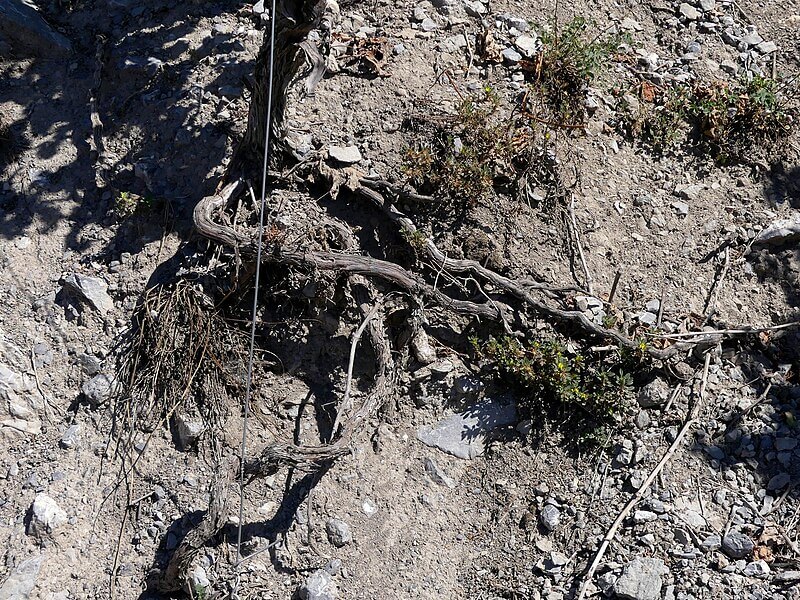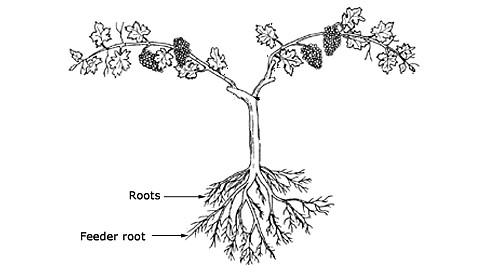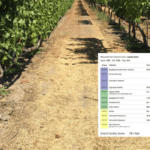Roots – the grapevine underground part of the plant, are multi-branched structures growing to various depths into the soil. Depending on the grape variety (rootstock), climate, and soil in which they grow, the grapevine root system differs in rooting pattern and depth. Grapevine roots have many functions and thus directly affect grape quality and quantity, therefore any winegrower wants to grow a healthy root system. Below are presented structures and functions of grapevine roots system, as well as the main management practices that winegrowers should pay attention to in order to grow healthy root system.
Structure of a grapevine root system
Mature grapevine roots system consists of older, woody roots (main or coarse roots), from which permanent roots grow either horizontally or vertically. Permanent roots are typically multi-branching, producing lateral roots that can further branch into smaller lateral roots. Number and placement of lateral roots depends on soil properties as they grow towards water and nutrient-rich areas. Lateral roots produce many short, fine roots (also known as feeder roots), which are responsible for resource acquisition.
Distribution of grapevine root system
Majority of the grapevine root system can be found in the top 3 feet (100 cm) of soil, while individual roots can grow to >30 feet (9 m) depth. While most of the fine roots are at depths of 10 to 60 cm (4-24 inch), with the highest density in the upper 20 cm (8 inch) of soil, main roots are usually found at a depth of 18-80 cm (7-32 inch) (Rijal, 2016). The distribution of roots depends on soil characteristics, impermeable layers, rootstock variety, and cultural practices used in cultivation. Since roots of the grapevine are very branched, and can expand to various depth and width, grapevine can thrive in soils that are less suitable for other plants.
- Soil
The root size and distribution is affected by the volume of soil that is available for the root growth, as well as soil properties, since roots detect available resources and grow preferentially in water- and nutrient-rich patches.
Fine-textured soil has a higher water holding capacity, and thus roots in silt and clay soil are normally shallower, while roots in coarse-textured soils are deeper.
- Rootstock
While grapevine can grow on it’s own root system, it can also be grafted onto a rootstock. Primarily the rootstock varieties were developed for European winegrape varieties (Vitis vinifera L.) as they are not resistant to phylloxera, a native North American insect. Most rootstocks are either native North American species or hybrids of two or more of these species, such as V. rupestris, V. riparia, and V. berlandieri.
Rooting pattern and depth vary among rootstocks, some rootstocks like Rupestris du Lot develop a very deep and almost vertical root system. That’s why this kind of rootstocks are suitable for dry and more infertile soil. While in the case of V. riparia rootstocks, the root system is more shallow and grow horizontally, requires deep and fertile soil.
Selection of rootstock variety is an important factor in vineyard development since rootstock can influence on vine growth, drought tolerance, pest resistance as well as nutrient uptake efficiency. And therefore help grapevine to growth in unfavorable (biotic and abiotic) environmental conditions, such as poor soil, low water, etc.
- Cultural practice
Cultural practices, such as irrigation system installed in the vineyard, cover crops, and tillage practice, affects the growth of the root system. The type of irrigation system has an effect on root distribution due to irrigation frequency, soil water availability, and spatial distribution of water and nutrients. While drip irrigated grapevines have a higher presence of roots near the trunk, the amount of roots under micro-sprinkler irrigation is higher as the distance of the trunk increases (vertical and horizontal directions), based on the study from Bassoi et. al. (2003).
Depending on the tilling depth and type of cover crop, root presence can be diminished in the upper 20 to 30 cm of soil. Moreover, the use of mulches or application of herbicides can increase root densities in the upper 20 cm of soil.
Grapevine root growth
Various factors affect root growth, such as pruning technique, irrigation, year, etc. therefore, the timing of root growth varies between the years. Based on several studies, roots develop primarily between pre-bloom (growth rate reaches it’s maximum at bloom, while after the bloom growth rate decreases), and veraison. While approaching the harvest time all of the grapevine resources are directed towards grapes ripening, and so typically roots don’t grow near harvest time. Little growth occurs also after the harvest, as well as in early spring. During the dormant season, grapevine roots can grow if the soil is warm enough, as in cold soil, roots don’t grow.

While the main roots are growing year by year, fine roots are constantly growing and renewing, they die within weeks after emergence and are continuously being replaced. New roots are of white color, and after a few weeks become brow, and eventually turn black. The browning of the roots means that their functional period has ended, however, they can still serve as a water pipe.
The function of the grapevine root system
Grapevine roots system has four functions: while woody roots (1) provide a physical anchor of the grapevine, are responsible for (2) transport, and storage of carbohydrates and nutrients for next season’s growth; fine roots (3) take up most of a vine’s water and nutrients from the soil. Grapevine roots also (4) produce hormones (gibberellin/cytokinin) that influence growth and development of the shoots and clusters of the grapevine.
Winegrower’s take on the grapevine root system
Growing a healthy root system is the key to produce high quality and quantity of grapes. Knowing the timing of root growth and development is important in order to implement appropriate management practices, such as fertilization, irrigation, floor management, etc. at the right time.
In the spring, when the roots reactivate, positive root pressure causes grapevine bleeding. As soil temperature reaches 45°F to 48°F (7.2°C-8,8°C), root absorptive activity increases and draws water up through the trunk’s xylem vessels, which results in sap flow, and increasing hydration of the buds. So in order for the buds to rehydrate, moist soil is required. In dry winters vines can’t initiate sap flow, so a delayed budbreak, stunted shoots growth, and poor fruit set can occur. It’s important to measure soil moisture before the budbreak, and irrigate if the soil is too dry.
The suction power of the root system is extreme and since the extraction of water is connected with transpiration of the water through grapevine leaves, the greater the evaporation, more extraction, and juices flow inside the grapevine is happening. So in conditions when the air is dry and warm with mild wind, evaporation is extremely high, and if there is a lack of water in the soil, the leaves may dry, and eventually, the whole grapevine can dry out. That’s why is important for winegrowers to know what’s the evaporation in their vineyard in order to know how much to irrigate.
Even though roots can grow at lower water potential than shoots, water deficit reduces root growth but favors root over shoot growth, therefore with appropriate irrigation management practice winegrowers can lower vine vigor. In case of severe water deficit phloem flow and root growth stop, and grapevine will live out of storage reserves which will reflect on poorer spring growth and next year crop ripening. If there is no water, then grapevine root system can’t uptake mineral nutrients from the soil. Minerals such as nitrogen and calcium must be dissolved in the water, while some other nutrients (phosphorous, potassium,..) roots can uptake by physical contact, and if the root growth stops, then due to lack of water grapevine can’t get those nutrients as well. In case of prolonged drought, roots can even dry out.
On the other hand, too much water in the soil decreases or even prevents breathing and growth of the roots, due to an inhibited oxygen supply.
In grapevine roots stored nutrients (nitrogen and starch reserves) are essential early in the growing season to support new vine growth, as well as about one month before harvest for fruit development. During these two periods, grapevine roots can’t supply enough nutrition from the soil, so having enough of nutrition reserves, stored in the roots, is crucial.
Apart from the water, grapevine requires a number of macro- and micro- nutrients for normal growth and development. Vineyard fertilization should always be based on soil and/or leaves analysis, while the timing of fertilizer application should be based on roots activity.
Conclusion
It is in the best interest of every winegrower to maximize grape quality in order to produce top quality wines. Quality of grapes is influenced also by the health of the grapevine root system. Knowing the structure and function of grapevine roots is the first step for winegrowers to produce top quality grape, and adjust vineyard management practices in changing climate.
Sources:
- Parts of the Grape Vine: Roots. By Ed Hellman, from Texas AgriLife Extension (online)
- Edward W. Hellman. Grapevine Sturcture and Function. Oregon Viticulture. GENCO Winemakers (online)
- D.R. Smart et. al. (2006). Grapevine Rooting Patterns: A Comprehensive Analysis and a Review. Am.J.Enol.Vitic. 57:1 (2006)
- Pickering, Gary & S, Wheeler. (2006). The effects of soil management techniques on grape and wine quality. WFL Publisher, Meri-Rastilan tie 3 C, Helsinki, Finland, pp.195-208
- J.M. Southey. (1992). Root Distribution of Different Grapevine Rootstocks on a Relatively Saline Soil. S.Afr.J.Enol.Vitic., Vol. 13, No.1, 1992
- Hunter, JJ & Archer, E & van Schalkwyk, Danie & Strever, Albert & Volschenk, C. (2016). Grapevine roots: interaction with natural factors and agronomic practices. Acta Horticulturae. 63-80. 10.17660/ActaHortic.2016.1136.10.
- L.H. Bassoi. et.al. (2003). Grapevine root distribution in drip and microsprinkler irrigation. Sci. agric. (Piracicaba, Braz.) vol.60 no.2 Piracicaba 2003
- Rijal, Jhalendra & Bergh, James. (2016). Food-Finding Capability of Grape Root Borer (Lepidoptera: Sesiidae) Neonates in Soil Column Bioassays. Journal of Entomological Science. 51. 000-000. 10.18474/JES15-21.1.
- Featured image: from narrowgateentrance.com





2 responses to “Structure and function of grapevine root system”
I have read quite a bit about the process of growing vines and making wines but where do I buy vines to start my vineyard? I have a nice piece of land in Malawi. I don’t know of any vineyards in the country. It only rains between December and April. Temperatures range between 15 and 35 degrees Celsius. It can get as low as 5 degrees at night.
Hello Newton, to find a vineyard in Malawi, you might use a search engine ;). If nobody is selling grapevines in Malawi, you can always order it from abroad, but it might be a good reason why is that so (climate, soil,…). Otherwise, most grapes for wine production are grown in climates located between the 30th and 50th parallel on the northern and southern hemisphere (you can find a map on this link: https://www.evineyardapp.com/blog/2019/01/17/climate-weather-and-vineyard-management/ ).